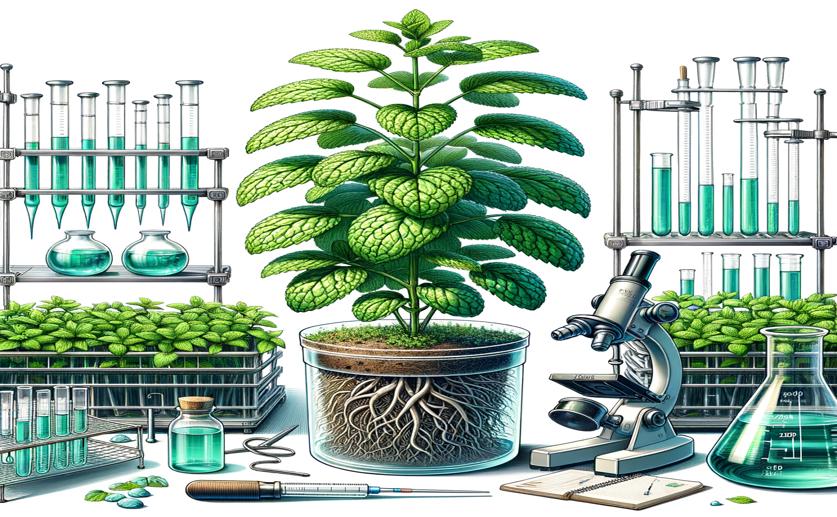Boosting Mint Growth and Valuable Acid Production in Lab Cultures

Image Source: Natural Science News, 2024
Key Findings
- In a study at Shahid Beheshti University, peppermint plants grew more and had more rosmarinic acid (RA) when treated with cyanobacteria
- The cyanobacteria treatment increased RA levels in peppermint by 2.3 times compared to untreated plants
- Plant hormones in the cyanobacteria, like auxins, may have caused the peppermint's growth and higher RA content
In the realm of medicinal plant research, scientists are continuously seeking ways to enhance the production of valuable compounds that have health-promoting properties. A recent study conducted by researchers at Shahid Beheshti University has made a significant discovery in this field, focusing on a compound known as rosmarinic acid (RA)[1]. RA is a phenolic compound found in various herbs, known for its antioxidant and anti-inflammatory effects. The study aimed to increase the production of RA in peppermint (Mentha piperita L.) plants using a novel approach involving cyanobacteria.
Peppermint is a widely used herb with a rich history in traditional medicine, and its potential health benefits have been the subject of many studies. For instance, RA extracted from peppermint has been shown to possess strong antioxidant properties[2]. Furthermore, RA has demonstrated antiviral activity against dengue virus, suggesting its potential as an antiviral agent[3]. These findings underscore the importance of increasing RA content in peppermint plants to maximize their medicinal value.
To achieve this, the researchers employed a native isolate of heterocystous cyanobacteria, Nostoc spongiaeforme var. tenue ISB65, and prepared a cyanobacterial lysate (CL). The peppermint plants were grown in vitro from apical meristem and inoculated with the CL. After 50 days, the growth indices, photosynthetic pigment content, and RA levels were measured in both the control and cyanobacteria-treated plants.
The results were promising. The CL inoculation led to a significant increase in the vegetative growth of the peppermint plants, including root and shoot length, plant biomass, and leaf number. Moreover, the treatment resulted in a 2.3-fold increase in the RA content, with the highest recorded level of RA being 7.68 mg per gram of dry weight in the treated plants, compared to 3.42 mg per gram of dry weight in the control group.
The study suggested that the presence of auxins, a type of plant hormone found in the CL, along with other chemical components such as potassium and calcium, may be responsible for the enhanced growth and phenolic compound production. These findings are particularly significant as they represent the first report of improved RA content in the tissue culture of medicinal plants treated with CL.
This research builds upon previous studies that have explored different methods to increase the RA content in plants. For example, a study on lemon balm (Melissa officinalis L.), which is also high in RA, demonstrated that the application of methyl jasmonate (MeJA) could significantly boost RA levels by influencing key genes in the phenylpropanoid pathway[4]. The Shahid Beheshti University study takes a different approach by using cyanobacteria as a bioelicitor, expanding the toolkit for enhancing medicinal metabolites in plants.
In summary, the study from Shahid Beheshti University offers a new and effective method for boosting the production of rosmarinic acid in peppermint plants through the use of cyanobacterial lysate. This advancement not only contributes to our understanding of plant growth and metabolite enhancement but also has practical implications for the pharmaceutical and nutraceutical industries, where the demand for naturally derived compounds like RA is ever-growing. The research paves the way for future studies to explore the use of cyanobacteria and other bioelicitors in the cultivation of medicinal plants, potentially leading to more efficient production of health-promoting phytochemicals.
BiotechBiochemPlant Science
References
Main Study
1) Cyanobacterial elicitor enhances the biomass of Mentha piperita L. and improves the production of high-value rosmarinic acid under in vitro culture of apical meristem.
Published 15th March, 2024
Journal: BMC plant biology
Issue: Vol 24, Issue 1, Mar 2024
Related Studies
2) Antioxidant Activity of Rosmarinic Acid Extracted and Purified from Mentha piperita.
Journal: Archives of Razi Institute, Issue: Vol 76, Issue 5, Nov 2021
4) Change in Secondary Metabolites and Expression Pattern of Key Rosmarinic Acid Related Genes in Iranian Lemon Balm (Melissa officinalis L.) Ecotypes Using Methyl Jasmonate Treatments.
https://doi.org/10.3390/molecules27051715
Related Articles





 17th February, 2024 | Jim Crocker
17th February, 2024 | Jim Crocker